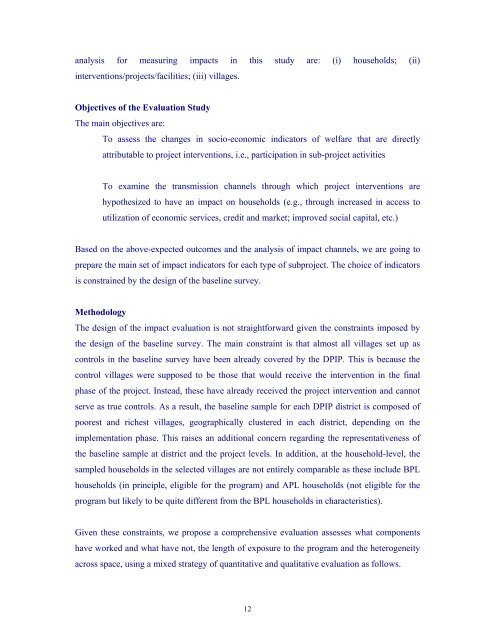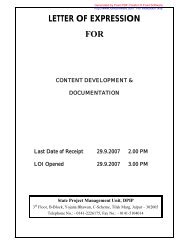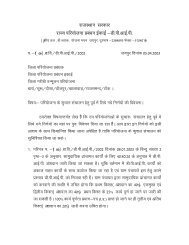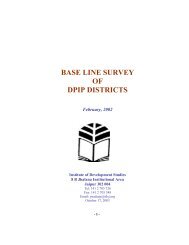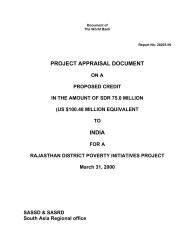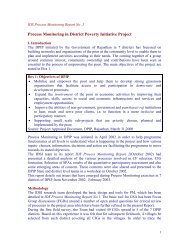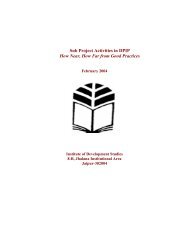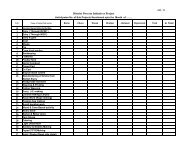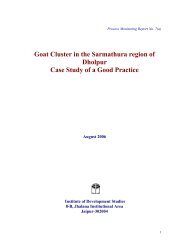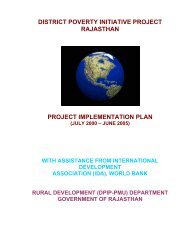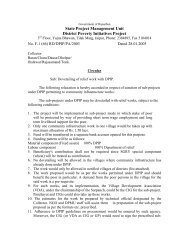Impact Assessment of the District Poverty Initiative Project Rajasthan
Impact Assessment of the District Poverty Initiative Project Rajasthan
Impact Assessment of the District Poverty Initiative Project Rajasthan
You also want an ePaper? Increase the reach of your titles
YUMPU automatically turns print PDFs into web optimized ePapers that Google loves.
analysis for measuring impacts in this study are: (i) households; (ii)<br />
interventions/projects/facilities; (iii) villages.<br />
Objectives <strong>of</strong> <strong>the</strong> Evaluation Study<br />
The main objectives are:<br />
To assess <strong>the</strong> changes in socio-economic indicators <strong>of</strong> welfare that are directly<br />
attributable to project interventions, i.e., participation in sub-project activities<br />
To examine <strong>the</strong> transmission channels through which project interventions are<br />
hypo<strong>the</strong>sized to have an impact on households (e.g., through increased in access to<br />
utilization <strong>of</strong> economic services, credit and market; improved social capital, etc.)<br />
Based on <strong>the</strong> above-expected outcomes and <strong>the</strong> analysis <strong>of</strong> impact channels, we are going to<br />
prepare <strong>the</strong> main set <strong>of</strong> impact indicators for each type <strong>of</strong> subproject. The choice <strong>of</strong> indicators<br />
is constrained by <strong>the</strong> design <strong>of</strong> <strong>the</strong> baseline survey.<br />
Methodology<br />
The design <strong>of</strong> <strong>the</strong> impact evaluation is not straightforward given <strong>the</strong> constraints imposed by<br />
<strong>the</strong> design <strong>of</strong> <strong>the</strong> baseline survey. The main constraint is that almost all villages set up as<br />
controls in <strong>the</strong> baseline survey have been already covered by <strong>the</strong> DPIP. This is because <strong>the</strong><br />
control villages were supposed to be those that would receive <strong>the</strong> intervention in <strong>the</strong> final<br />
phase <strong>of</strong> <strong>the</strong> project. Instead, <strong>the</strong>se have already received <strong>the</strong> project intervention and cannot<br />
serve as true controls. As a result, <strong>the</strong> baseline sample for each DPIP district is composed <strong>of</strong><br />
poorest and richest villages, geographically clustered in each district, depending on <strong>the</strong><br />
implementation phase. This raises an additional concern regarding <strong>the</strong> representativeness <strong>of</strong><br />
<strong>the</strong> baseline sample at district and <strong>the</strong> project levels. In addition, at <strong>the</strong> household-level, <strong>the</strong><br />
sampled households in <strong>the</strong> selected villages are not entirely comparable as <strong>the</strong>se include BPL<br />
households (in principle, eligible for <strong>the</strong> program) and APL households (not eligible for <strong>the</strong><br />
program but likely to be quite different from <strong>the</strong> BPL households in characteristics).<br />
Given <strong>the</strong>se constraints, we propose a comprehensive evaluation assesses what components<br />
have worked and what have not, <strong>the</strong> length <strong>of</strong> exposure to <strong>the</strong> program and <strong>the</strong> heterogeneity<br />
across space, using a mixed strategy <strong>of</strong> quantitative and qualitative evaluation as follows.<br />
12


